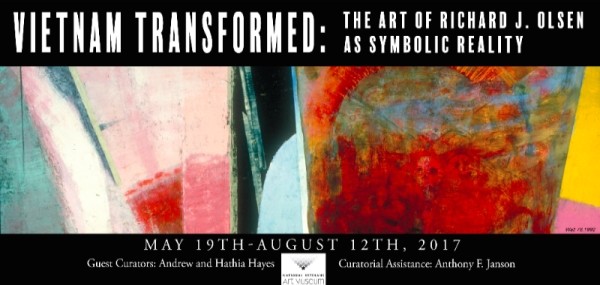
During his graduate studies at the University of Wisconsin, Olsen’s artistic approach was to represent the likeness of people, places and events from his life. After accepting a faculty position at the University of Georgia in 1969, he felt pressure to move toward pure abstraction and leave behind his representations of the Vietnam War. He spent time experimenting with a variety of painting techniques, and once again began adding abstracted images pulled from his experience in Vietnam.
Despite mastering these methods of painting, Olsen struggled to find his voice and legitimacy and continued to ask himself “What do I paint”? In 1977, he took the advice of an artist’s cliché, “If you don’t know what to paint, paint your studio wall” and covered the walls of his studio with canvas and let them depict different aspects of his artistic life. These early canvases were the beginning of his “Wall” series.
By the mid-1980s, Olsen’s approach to both painting and subject matter became clear. He constructed collages, which he called “Calculations,” on grid paper as blueprints for his larger canvases. He depicted his previous works in these collages, and continued this method, adding images of previous paintings and objects in his studio.
Olsen’s “Wall” designs are intended to be allegorical by linking the pictoral artifacts of his Vietnam wartime experiences to systems of meaning – the balance of good/evil, and the legends traditions of culture. Olsen’s war experiences are made real to viewers by the collection of pictoral symbols within each painting and linking the imagery to higher-level meanings.
Olsen’s work aims to surpass an automatic response in viewers by using multiple symbols in compositions that invite, even demand, close inspection and stimulate further thought by providing a context from which the underlying meaning can emerge. Olsen links the visual, emotional, psychological, cultural, and social elements of his Vietnam wartime experiences to much larger primary issues concerning the continued tension between good and evil found in all societies. Through his art, Olsen has elevated the Vietnam War to a universal plane to create an allegory of human existence. His paintings are allegories that rely upon historical and philisophical systems, but they also add new layers to the fundamental meanings of war that are essentially without precedent in art and art history.
About the National Veterans Art Museum
Located in Chicago IL, the National Veterans Art Museum’s (NVAM) comprehensive permanent collection of combat inspired art comprises over 2,500 pieces. The collection includes art from the time of World War II to the present day. The collection was built to evoke an understanding of the impact of combat on the individuals who served as well as our society at large. And the permanent collection—spanning over 30 years—continues to grow it includes painting, print, photography and sculpture. While the NVAM is one of the only museums in the world to collect and exhibit artwork exclusively created by veterans in a permanent exhibition, it also provides important programming for veterans, their families, and the community. For more information about the National Veterans Art Museum, visit www.nvam.org, or call 312-326-0270.








